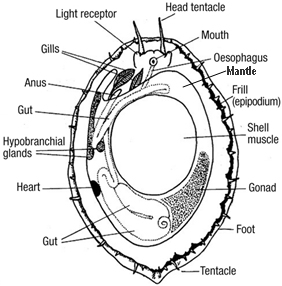Haliotis cracherodii
Haliotis cracherodii, commonly known as the black abalone, is a species of marine gastropod in the family Haliotidae. This species is native to the coastal waters of the eastern Pacific Ocean, particularly along the coasts of California and Baja California.
Description[edit | edit source]
The black abalone has a distinctive, oval-shaped shell that is typically dark blue to black in color. The shell is characterized by a series of respiratory pores, which are used for breathing and expelling waste. The interior of the shell is iridescent, displaying a range of colors from blue to green to silver. Adult black abalones can reach a size of up to 20 centimeters in length.
Habitat[edit | edit source]
Black abalones are typically found in rocky intertidal zones, where they cling to rocks and feed on algae. They prefer areas with strong wave action, which helps to provide a constant supply of food and oxygen.
Diet[edit | edit source]
The primary diet of Haliotis cracherodii consists of various types of algae, including kelp and other macroalgae. They use their radula, a specialized feeding organ, to scrape algae off the surfaces of rocks.
Reproduction[edit | edit source]
Black abalones are broadcast spawners, meaning they release their eggs and sperm into the water column, where fertilization occurs. The larvae are planktonic and eventually settle onto the substrate, where they develop into juvenile abalones.
Conservation Status[edit | edit source]
The black abalone is currently listed as an endangered species due to a combination of factors, including overfishing, habitat destruction, and disease. One of the most significant threats to their population is the withering syndrome, a disease caused by a bacterium that affects the digestive system of abalones.
Related Pages[edit | edit source]
See Also[edit | edit source]
References[edit | edit source]
External Links[edit | edit source]
Search WikiMD
Ad.Tired of being Overweight? Try W8MD's NYC physician weight loss.
Semaglutide (Ozempic / Wegovy and Tirzepatide (Mounjaro / Zepbound) available. Call 718 946 5500.
Advertise on WikiMD
|
WikiMD's Wellness Encyclopedia |
| Let Food Be Thy Medicine Medicine Thy Food - Hippocrates |
Translate this page: - East Asian
中文,
日本,
한국어,
South Asian
हिन्दी,
தமிழ்,
తెలుగు,
Urdu,
ಕನ್ನಡ,
Southeast Asian
Indonesian,
Vietnamese,
Thai,
မြန်မာဘာသာ,
বাংলা
European
español,
Deutsch,
français,
Greek,
português do Brasil,
polski,
română,
русский,
Nederlands,
norsk,
svenska,
suomi,
Italian
Middle Eastern & African
عربى,
Turkish,
Persian,
Hebrew,
Afrikaans,
isiZulu,
Kiswahili,
Other
Bulgarian,
Hungarian,
Czech,
Swedish,
മലയാളം,
मराठी,
ਪੰਜਾਬੀ,
ગુજરાતી,
Portuguese,
Ukrainian
Medical Disclaimer: WikiMD is not a substitute for professional medical advice. The information on WikiMD is provided as an information resource only, may be incorrect, outdated or misleading, and is not to be used or relied on for any diagnostic or treatment purposes. Please consult your health care provider before making any healthcare decisions or for guidance about a specific medical condition. WikiMD expressly disclaims responsibility, and shall have no liability, for any damages, loss, injury, or liability whatsoever suffered as a result of your reliance on the information contained in this site. By visiting this site you agree to the foregoing terms and conditions, which may from time to time be changed or supplemented by WikiMD. If you do not agree to the foregoing terms and conditions, you should not enter or use this site. See full disclaimer.
Credits:Most images are courtesy of Wikimedia commons, and templates, categories Wikipedia, licensed under CC BY SA or similar.
Contributors: Prab R. Tumpati, MD





